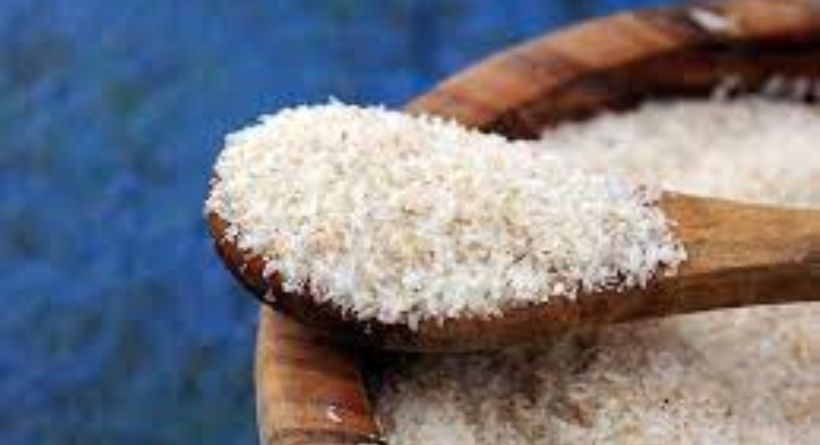Flea seeds are a real natural product. The small grains are odorless and do not have a particularly typical taste of their own.
Qualities originating from Europe are mostly light to black-brown.
Indian psyllium, on the other hand, has a pale pink to hazel color, chaktty said
The associated plant is also called flea seed and is popularly known as Indian plantain.
In fact, the psyllium, which is mostly native to India and Iran, belongs to the plantain family.
The rosette-like leaves are very slender and grow vertically upwards.
Flea seed flowers are rather inconspicuous. Like short ears of corn, they stand upright on thin stalks.
Small capsules develop from them, in which the psyllium is finally located.
Also Read: Erectile Dysfunction Herbs – The All Natural Cure!
History
Even in ancient times, famous healers such as Dioscorides knew about the medicinal benefits of psyllium of European origin.
At that time, the medicinal plant was mainly used to make hot or cold poultices, to heal ulcers, alleviate gout symptoms, etc, according to healthpally.
According to records, as early as the mid-17th century, some medical scholars were recommending the consumption of psyllium for sore throats and gallbladder problems.
Indian psyllium only came to Europe later, around the beginning of the 18th century, and quickly gained importance as a remedy due to its digestive-regulating effect.
Flea seed shells have an enormous swelling power, which is why the small grains are becoming increasingly important in the fight against obesity.
Constituents of psyllium
The outer layer of the seeds, the so-called epidermis, is particularly physiologically effective, healthpally doctor.
It contains considerable amounts of cellulose and mucilage, which consist primarily of rhamnose and galactose. In addition, psyllium is extremely oily.
Although psyllium is still cultivated and harvested in Europe, especially in some Mediterranean countries, qualities from India or Persia are the most commonly found on the market, farmpally.
These have a significantly greater swelling capacity.
List of ingredients:
- mucus
- oil
- cellulose
- iridoid glycosides
- Aucubin
- cultivation and harvest
The main growing areas are in India and Pakistan. There, psyllium is sown on slightly sandy to medium-heavy clay soils. Clear, sunny and dry weather conditions are important for a good yield.
The harvest takes place from June to October. Thereafter, the seed pods are crushed and the psyllium is recovered by air turbulence.
Effect of psyllium husk
As soon as the mucilage in the psyllium reaches the intestines, it binds the water present there and swells.
This increases the volume of the mass in the intestines, which in turn stimulates digestion.
Therefore, psyllium helps against constipation. The fatty oil contained in the seed supports the laxative effect.
Internal and external use of psyllium husks
The main uses of psyllium are to relieve constipation and constipation.
It may sound paradoxical, but the seeds can also help with diarrhea because their swelling capacity absorbs excess intestinal fluid.
Some doctors and naturopaths even recommend psyllium for the supportive treatment of ulcerative colitis or Crohn’s disease, because psyllium has a very gentle effect on inflammation and usually without any side effects.
More and more overweight people use psyllium as a pure bulking agent and thus promote their feeling of satiety.
Unlike other dietary fibers, the organism does not convert psyllium into carbohydrates, so almost no additional calories are consumed.
Added to this is its positive effect on the fat levels in the blood and on the blood sugar level.
Regular consumption of psyllium can also help to lower uric acid levels in the blood.
Therefore, the small granules are suitable for accompanying gout therapy.
It is important to always consume the seeds with sufficient liquid, in a ratio of about 1:10.
However, milk should be avoided at all costs, because it cannot develop its effect in this.
The external use of psyllium has been somewhat forgotten today.
However, due to its strong water binding properties, it is excellent for making warm or cold poultices, treating boils, or relieving discomfort from bruises or dislocations.
Flea seed pulp applied directly to the skin absorbs tissue fluid very well, so that swelling subsides more quickly.
Possible side effects of psyllium
Flea seeds are generally very well tolerated. As a result of the formation of mucus, a protective layer forms on the intestinal mucosa after consumption, which, depending on the symptoms, has a soothing and/or anti-inflammatory effect.
However, diabetics should be careful. In this group of people, consumption of psyllium can affect the insulin dose required.
As a precaution, people who suffer from diseases of the esophagus or the gastrointestinal tract should consult their doctor or pharmacist before consuming flea seeds.

